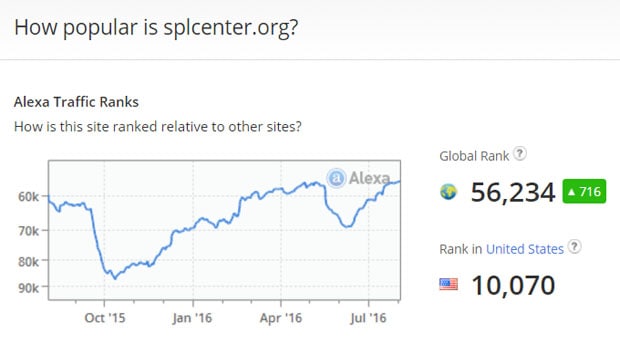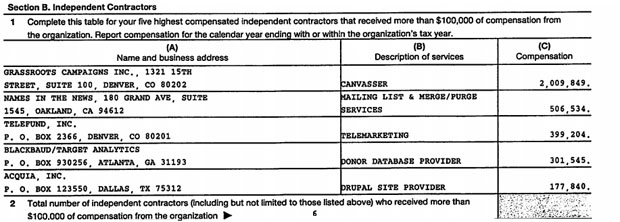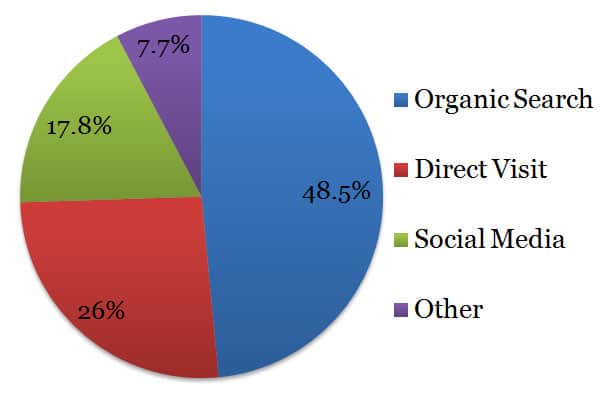AmRen vs. SPLC
Chris Roberts, American Renaissance, August 5, 2016
One of my responsibilities at American Renaissance is to keep tabs on how our website is doing. That means, among other things, monitoring its popularity, figuring out how new readers discover us, and making sure the ads we run are not too annoying. This is complicated internet stuff that makes people’s eyes glaze over. I also manage the finances and budget of American Renaissance — another eye-glazing job.
Still, I would like to share with American Renaissance readers and supporters just a few numbers that show what a great impact American Renaissance has on a very small budget. For context, I will compare a few of our numbers with those of our anti-white friends at the Southern Poverty Law Center.
Let’s start with website popularity. These numbers come from Alexa.com, the most reliable monitor of website popularity.


In the US, our websites are neck-and-neck. The SPLC is ranked about 7 percent higher than AR.
Let’s give these numbers a bit of context, though. First, American Renaissance is blocked by many universities, restaurants, airports, public libraries, and secondary schools. The SPLC is blocked by no one. Second, the SPLC was founded in 1971, AR was founded in 1990. Even with their almost two decade head start, they have managed a meager 7 percent higher web ranking in the US. Third, the difference in personnel is huge. American Renaissance has three employees: myself, Henry Wolff, and Jared Taylor. The SPLC doesn’t even list all its employees, but it includes no fewer than 17 just in “leadership” positions.
Finally, the SPLC’s blather is supported by the media, the government, universities, churches, elected officials, and public schools. They are fighting for the downtrodden, unmasking evil, combating “hate,” handing out love by the double handful. We, or course, are “pseudo-scientific” enemies of goodness, truth, and beauty.
Then there is money. Everyone knows the Southern Poverty Law Center is loaded, but let’s be specific. The property of their headquarters in Alabama is worth over 7 million dollars, and that is not counting the value of their offices in Florida, Louisiana, and Mississippi.
But when compared to their salaries, the SPLC’s property value does not look that exorbitant. Here are the reported incomes of their highest-paid employees, per their 2014 tax returns (pages 7 and 8):
| Name | Title | Reportable compensation from the organization | Estimated other compensation from the organization and related organizations |
| Richard Cohen | President/CEO | $333,296 | $74,122 |
| Lisa Sahulka | COO | $176,511 | $26,839 |
| Teenie Hutchison | Secretary/Treasurer | $154,457 | $37,543 |
| Morris Dees | Chief Trial Counsel | $337,146 | $45,546 |
| Joseph J. Levin, Jr. | General Counsel | $160,626 | $41,841 |
| Wendy Via | Chief Development and Communications Officer | $186,645 | $35,769 |
| Mark Potok | Senior Fellow | $138,583 | $31,404 |
| Jerri Katzerman | Deputy Legal Director | $183,752 | $43,297 |
| David Utter | Juvenile Justice Policy St | $136,039 | $23,323 |
| Heidi Beirich | Director/Intel Project | $138,605 | $17,791 |
The second two columns add to more than $2.3 million. One wonders if any employees see the irony in making over $200,000 working at a “nonprofit” with the word “poverty” in its name. This form — Form 990 — reports the salaries only of employees making more than 100,000 dollars a year. That is why if you look at our Form 990, Jared Taylor, Henry Wolff, and I are not listed. The three of us together make less money than any of the people listed above.
The SPLC also spends a lot of money on fundraising — spending money to make money. This is from the same 990:

While it is easy to look at high fundraising costs and conclude they are inefficient, the SPLC is actually doing a good job. Their reported income for 2014 was over 54 million dollars — bringing their total assets to more than 3oo million dollars. They’re getting a good return.
What are they doing with all that money? Not increasing web traffic.
While it is true that the SPLC has many expensive non-website projects — mainly lawsuits — their website is not that different from ours. Like American Renaissance, they have daily news items. While American Renaissance has reports such as “The Color of Crime” the SPLC has its “Hate Map” and “Intelligence Report” about organizations they do not like.
In short, both the AR and the SPLC sites keep up with the news, and give regular commentary on racial matters, largely focusing on the United States. The biggest differences between the two are perspective — they’re wrong and we’re right — and funding. The SPLC raises tens of millions of dollars a year. In a good year, we raise a couple of hundred thousand.
Why, with this incredible imbalance of resources and allies, is the SPLC website basically no more popular than ours? Because American Renaissance tells the truth, and more and more Americans want the truth.
I know this because I can see how people arrive to our website. Almost half get here after a Google search:

Sources of traffic to AmRen.com.
I promise you this is not common. Most websites do not get even half the percentage of visitors AR does from people searching phrases online. Most websites have a “super majority” of traffic coming from “direct visits,” that is to say, people just typing in the web address. These people know where they want to go. It’s when they don’t know where to go that people do a Google search and discover something new. No fewer than 48.5 percent of our visitors get to our site that way.
What kind of searches lead them to American Renaissance? It’s the kind of thing white people worry and wonder about, but can’t exactly just ask their neighbor. Nor can they trust the nightly news. Here are the some of the search terms that bring people to AmRen.com:
- Interracial crime
- Rape by race
- Race and crime
- Interracial murder
- Hispanic crime
- White fertility
People wonder about these things, search for them, find American Renaissance, and stay as regular readers. As they should. This is one of the few places they will get the truth.
This is why I am so proud to work for American Renaissance. We report the facts no one else will — and we make every single cent count. To all of our donors, I would like to say, “Thank you.” You make it possible for whites around the world to find American Renaissance and discover the truth about race.
And because I’m the finance guy, I ask all of our loyal readers to consider supporting American Renaissance today. You can easily donate once online, or pledge monthly.















